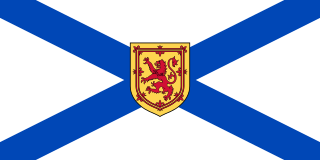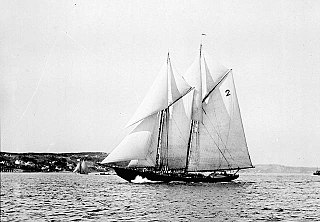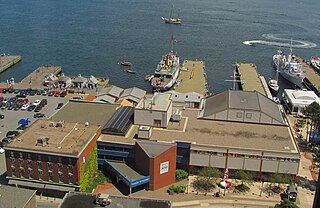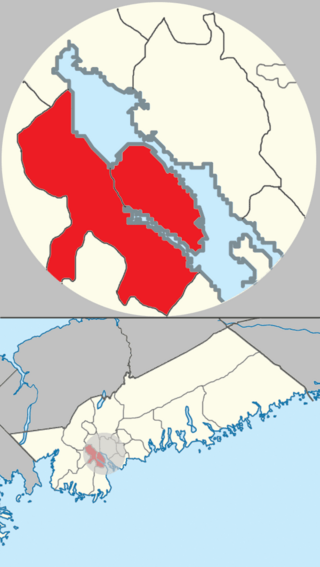
Nova Scotia is a province of Canada, located on its east coast. It is one of the three Maritime provinces.

Bluenose was a fishing and racing gaff rig schooner built in 1921 in Lunenburg, Nova Scotia, Canada. A celebrated racing ship and fishing vessel, Bluenose under the command of Angus Walters, became a provincial icon for Nova Scotia and an important Canadian symbol in the 1930s, serving as a working vessel until she was wrecked in 1946. Nicknamed the "Queen of the North Atlantic", she was later commemorated by the Bluenose one-design sloop (1946) and a replica, Bluenose II (1963). The name Bluenose originated as a nickname for Nova Scotians from as early as the late 18th century.

Citadel Hill is a hill that is a National Historic Site in Halifax, Nova Scotia, Canada. Four fortifications have been constructed on Citadel Hill since the city was founded by the English in 1749, and were referred to as Fort George—but only the third fort was officially named Fort George. According to General Orders of October 20, 1798, it was named after King George III. The first two and the fourth and current fort, were officially called the Halifax Citadel. The last is a concrete star fort.

On the morning of 6 December 1917, the French cargo ship SS Mont-Blanc collided with the Norwegian vessel SS Imo in the harbour of Halifax, Nova Scotia, Canada. Mont-Blanc, laden with high explosives, caught fire and exploded, devastating the Richmond district of Halifax. At least 1,782 people were killed, largely in Halifax and Dartmouth, by the blast, debris, fires, or collapsed buildings, and an estimated 9,000 others were injured. The blast was the largest human-made explosion at the time. It released the equivalent energy of roughly 2.9 kilotons of TNT (12 TJ).

The Maritime Museum of the Atlantic is a maritime museum located in downtown Halifax, Nova Scotia, Canada.

The Royal Canadian Navy is the naval force of Canada. The navy is one of three environmental commands within the Canadian Armed Forces. As of February 2024, the RCN operates 12 Halifax-class frigates, 12 Kingston-class coastal defence vessels, 4 Victoria-class submarines, 4 Harry DeWolf-class offshore patrol vessels, 8 Orca-class patrol vessels, and several auxiliary vessels. The RCN consists of 8,400 Regular Force and 4,100 Primary Reserve sailors, supported by 3,800 civilians. Vice-Admiral Angus Topshee is the commander of the Royal Canadian Navy and chief of the Naval Staff.

Halifax is the capital and most populous municipality of the Canadian province of Nova Scotia, and the most populous municipality in Atlantic Canada. As of 2023, it is estimated that the population of the Halifax CMA was 518,711, with 348,634 people in its urban area. The regional municipality consists of four former municipalities that were amalgamated in 1996: Halifax, Dartmouth, Bedford, and Halifax County.

Canadian Forces Base (CFB) Halifax is Canada's east coast naval base and home port to the Royal Canadian Navy Atlantic fleet, known as Canadian Fleet Atlantic (CANFLTLANT), that forms part of the formation Maritime Forces Atlantic (MARLANT).

Edward Cornwallis was a British career military officer and member of the aristocratic Cornwallis family, who reached the rank of Lieutenant General. After Cornwallis fought in Scotland, putting down the Jacobite rebellion of 1745, he was appointed Groom of the Chamber for King George II. He was then made Governor of Nova Scotia (1749–1752), one of the colonies in North America, and assigned to establish the new town of Halifax, Nova Scotia. Later Cornwallis returned to London, where he was elected as MP for Westminster and married the niece of Robert Walpole, Great Britain's first Prime Minister. Cornwallis was next appointed as Governor of Gibraltar.

Halifax Harbour is a large natural harbour on the Atlantic coast of Nova Scotia, Canada, located in the Halifax Regional Municipality. Halifax largely owes its existence to the harbour, being one of the largest and deepest ice-free natural harbours in the world. Before Confederation it was one of the most important commercial ports on the Atlantic seaboard. In 1917, it was the site of the world's largest man-made accidental explosion, when the SS Mont-Blanc blew up in the Halifax Explosion on December 6.

The community of Halifax, Nova Scotia was created on 1 April 1996, when the City of Dartmouth, the City of Halifax, the Town of Bedford, and the County of Halifax amalgamated and formed the Halifax Regional Municipality. The former City of Halifax was dissolved, and transformed into the Community of Halifax within the municipality.

Theodore Tugboat is a Canadian children's television series about a tugboat named Theodore who lives in the Big Harbour with all of his friends. The show originated aired from 1993-2001 in Halifax, Nova Scotia, Canada as a co-production between the CBC, and the now defunct Cochran Entertainment, and was filmed on a model set using radio controlled tugboats, ships, and machinery. Production of the show ended in 2001, and its distribution rights were later sold to Classic Media. The show premiered in Canada on CBC Television, then went to PBS, was on Qubo in the United States, and has appeared in eighty different countries.

CSS Acadia is a former hydrographic surveying and oceanographic research ship of the Hydrographic Survey of Canada and its successor the Canadian Hydrographic Service.

Sambro Island Lighthouse is a landfall lighthouse located at the entrance to Halifax Harbour, Nova Scotia, on an island near the community of Sambro in the Halifax Regional Municipality. It is the oldest surviving lighthouse in North America and its construction is a National Historic Event.

HMCS Oriole is the sail training vessel of the Royal Canadian Navy based at CFB Halifax in Halifax, Nova Scotia. She is a sailing ketch, currently the oldest commissioned vessel in the Royal Canadian Navy, and also the longest serving commissioned ship. Originally the yacht Oriole IV, the vessel was acquired by the Royal Canadian Navy during the Second World War, then returned to private ownership at the end. Oriole IV was reacquired during the Cold War for use on the East Coast of Canada before switching to the West Coast of Canada in 1956. In 2018, the training vessel returned to the East Coast.

SSMont-Blanc was a cargo steamship that was built in Middlesbrough, England in 1899 for a French shipping company. On Thursday morning, December 6, 1917, she entered Halifax Harbour in Nova Scotia, Canada laden with a full cargo of highly volatile explosives. As she made her way through the Narrows towards Bedford Basin, she was involved in a collision with Imo, a Norwegian ship. A fire aboard the ship ignited her cargo of wet and dry 2,300 tons of picric acid, 500 tons of TNT, and 10 tons of guncotton. The resultant Halifax Explosion killed approximately 2,000 people and injured about 9,000.

The Battle off Halifax took place on 28 May 1782 during the American Revolutionary War. It involved the American privateer Jack and the 14-gun Royal Naval brig HMS Observer off Halifax, Nova Scotia. Captain David Ropes commanded Jack, and Lieutenant John Crymes commanded Observer. The battle was "a long and severe engagement" in which Captain David Ropes was killed.
Erg was a vessel built and owned by Halifax Steamship Ltd. in 1915. She was used to ferry workers across the harbour to vessels under repair during the Second World War. Erg was sunk in the Halifax Harbour three times and is currently located in the Bedford Basin.

James Battle was a fireboat, which operated in Detroit, Michigan, Halifax, Nova Scotia, and Montreal, Quebec.

Although it is a busy port, there is sparse record of fireboats in Halifax, Nova Scotia.




















